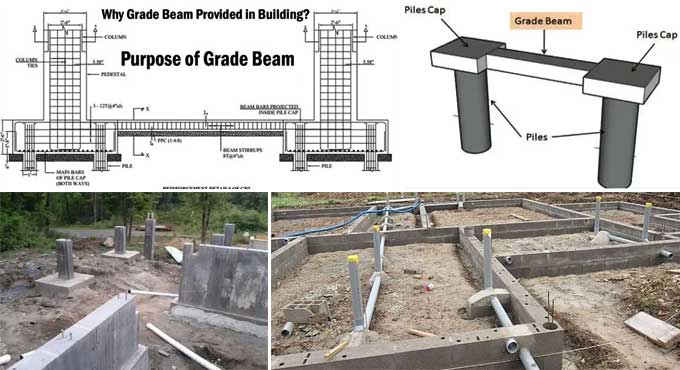NEWS | SOFTWARE | SHEET
Grade Beam - Foundation, Construction Process, Advantages and Disadvantages
A grade beam also differs from a strap beam because it is used to redistribute the weight of a column between a series of foundations, while a strap beam is used to lighten the load on a column between foundations.
Unlike basement footings, grade beams are designed to bend and span between pile caps or caissons, while basement footings bear directly on the ground and transfer wall weight directly to it. If there are large moments from lateral loads, it may be combined with spread footings, reducing the size of each spread footing.
Generally, Grade Beams are built at Grade level and are used mainly for building pile caps. A grade beam is a concrete piece that acts as a horizontal tie between pile caps and footings.
In general, pile caps or caissons transmit the load from a bearing wall into spaced ground foundations. The soil bearing capacity of these beams is usually less than the anticipated design loads.
There is the possibility that it was either designed to rest directly on the soil of spans between piles or above the soil spans. For foundations requiring deep soil penetration, grade beams are an ideal choice.
Grade Beam Design
In most cases, grade beams are designed to support the weight of the walls. In the first place, you must calculate the load per meter of the wall. You should then calculate the beams self weight. For beams, you would usually assume that their depth is equal to their length ten times.
As a next step, you need to analyze your beam by getting a moment and shear force diagram, regardless of whether it is a supported or continuous beam. You can calculate the area of steel required for longitudinal reinforcement of a beam with a single maximum moment at mid span.
At the bottom, there will be the main reinforcement and at the top, you will always have two bars. The distance between stirrups depends on the code you use, but you have to design for shear as well. The procedure for continuous beams is similar, but with a negative moment at the support, and the main reinforcement placed on top.
Construction Process of Grade Beam
Excavation & Preparation
First, grade beams should be prepared and excavated. Trenches are excavated according to the level of the beams. It is also possible to construct beams on the ground directly, in which case the ground surface must be leveled and prepared before the beams are constructed.
Framework Installation
Once preparation and excavation have been completed, the beam forms are placed according to their dimensions. The bottom of the forms is placed earlier to the sides of the beams if they are constructed on the ground. Keeping the reinforcement cage on the flat soling brick allows you to fix the side shuttering.
When the grade beam is constructed above ground, the framework is constructed similarly to conventional beams. Therefore, both sides and the bottom of the grade beam need shutters. When the beam framework is completed, the designated grade beam dimensions should be provided, which should have sufficient reinforcement cover.
Reinforcement Placement
It is indicated in the structural drawing where reinforcement is to be placed for the grade beam. A structural drawing describes the length, number, and spacing of stirrups, as well as the size and number of longitudinal reinforcements.
Check the length and placement of the laps, spacers, hooks, and clear reinforcement cover, as well as the number and size of top, bottom, and extra reinforcements.
Concrete Pouring
It is now time for concrete to be poured onto the grade beam. The use of ready mix concrete or machine mixed concrete on site is both acceptable for concrete projects.
After pouring concrete, the side support of the grade beam can be poured 24 hours later. The bottom formwork should be removed only when the concrete is strong enough to be removed.
Define Grade Beam Foundation
All superstructure loads are safely transferred to subsoil strata using the Grade Beam Foundation. It is necessary to decide the depth and size of the beam according to the intensity of the load that is expected to come and as well as the bearing capacity of the foundation soil on the construction site.
The depth of the grade beam should not be less than 150 millimeters. Beams used on grade are stronger than beams used on plinths. In addition, they bear the weight of the above mentioned masonry walls.
A grade beam foundation consumes less concrete than a conventional foundation. Building a basement is impossible with a grade beam foundation. Grade beams are reinforced at the top and bottom with a minimum of three bars of 10 mm diameter.
Benefits of Grade Beam
In addition to supporting the soil before the concrete is poured, these beams are also capable of supporting the concrete while it is being poured. It saves time and money by requiring less excavation work. As a result, both time and money were saved during the construction process.
To get more details, go through the following video tutorial.
Lecturer: Focus Civil Work
Grade beams are flexible in nature since they can be manufactured in any size and shape. In addition to rebar, conduits, pipes, and dowels, they can easily penetrate other materials.


